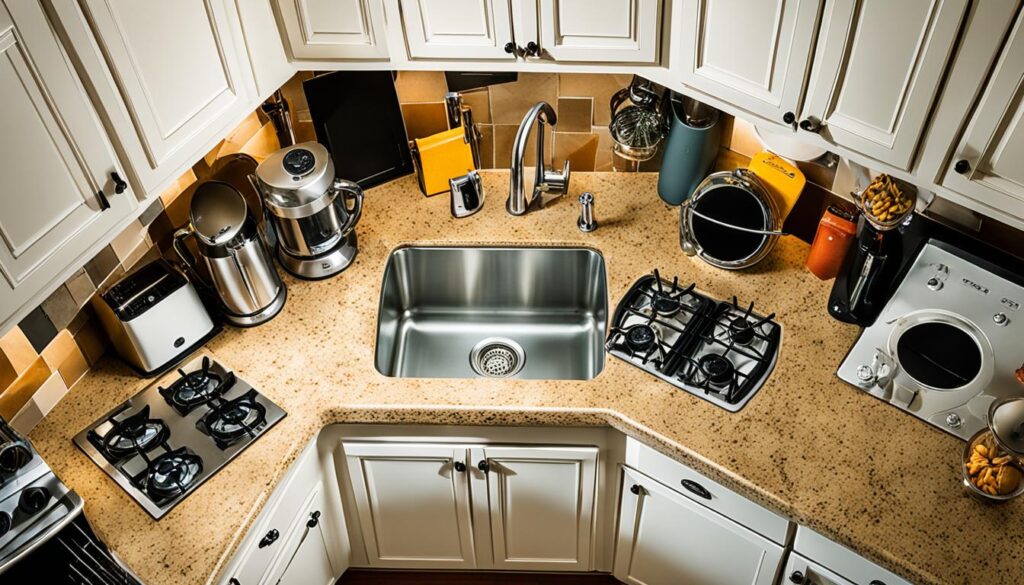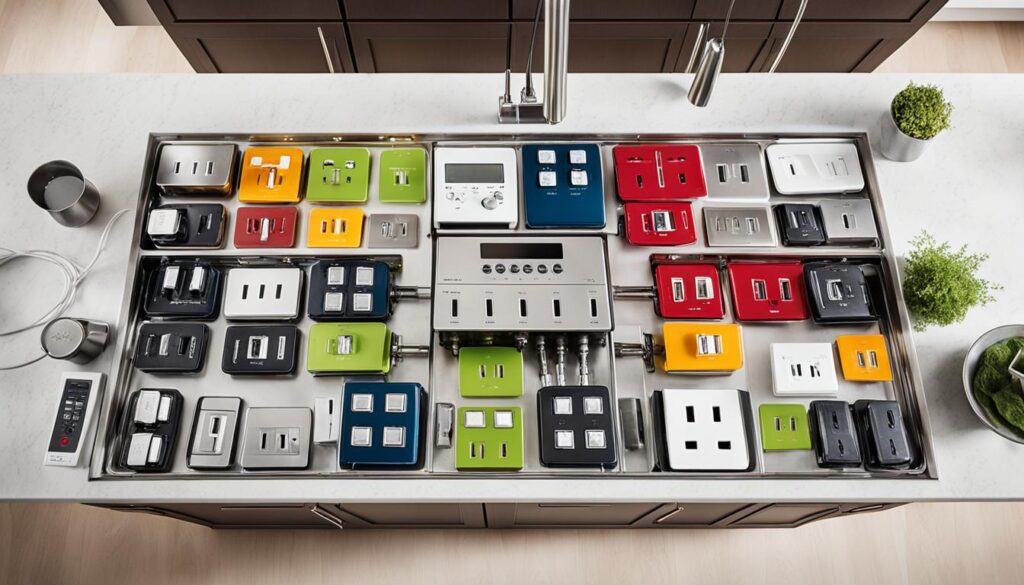When it comes to kitchen outlets, proper placement is essential for both functionality and safety. This guide will provide you with expert tips on how to optimize the placement of your kitchen outlets during renovations and upgrades. We’ll cover everything from installation and wiring to safety considerations and maintenance. With this information, you’ll be able to create a kitchen that is both efficient and safe to use.
Key Takeaways:
- Proper placement of kitchen outlets is crucial for functionality and safety.
- Optimize outlet placement during kitchen renovations to ensure convenience.
- Hire a professional electrician for safe and compliant installation.
- Consider the kitchen triangle and convenient placement of outlets.
- Determine the right number of sockets based on your appliance needs.
Planning the Layout: A Priority for Outlet Placement
When designing a kitchen, one of the key considerations is the placement of electrical outlets. This important aspect of kitchen design should not be overlooked, as it directly impacts the convenience and functionality of your space. To create a kitchen that caters to your daily cooking, baking, and brewing-up rituals, it’s crucial to prioritize outlet placement and envision yourself in the space.
When planning the layout of your kitchen, think about the positioning of outlets in relation to your appliances and workspaces. Take into account the areas where you’ll need access to power the most, such as near countertops and workstations. By strategically placing outlets in these locations, you’ll be able to easily plug in and use your appliances without the hassle of tangled wires.
One effective approach is to consider the concept of the “kitchen triangle,” which consists of the sink, cooker, and refrigerator. This is the primary working area in the kitchen, and having outlets conveniently located in this space will make it easier to use your appliances while preparing meals. Additionally, consider the future placement of appliances that you may want to add to your kitchen, such as a built-in coffee maker or a wine cooler, and plan for outlets accordingly.
By taking the time to plan the layout of your kitchen and prioritize outlet placement, you can ensure that your cooking space is designed for maximum efficiency and convenience. Whether it’s preparing meals, brewing your favorite coffee, or baking delicious treats, having easy access to power will enhance your overall kitchen experience.

Safety First: Hiring a Professional Electrician
When it comes to ensuring the safety of your kitchen outlets, hiring a qualified electrician should be your top priority. Electrical work in kitchens requires specialized knowledge and expertise to meet safety standards and regulations. By working with a qualified electrician, you can have peace of mind knowing that every aspect of your kitchen outlets, from installation to wiring, will be handled with precision and care.
A professional electrician who specializes in kitchen installations understands the unique safety considerations involved. They are well-versed in electrical codes and regulations, ensuring that your kitchen outlets are compliant and safe to use. They will carefully assess and determine the optimal placement of outlets, considering factors like distance requirements from sinks and worktops. By relying on their expertise, you minimize the risk of electrical hazards and create a secure environment in your kitchen.
One important factor to consider when hiring an electrician for your kitchen outlets is their qualification and accreditation. Look for an electrician who is a NICEIC-approved contractor. The National Inspection Council for Electrical Installation Contracting (NICEIC) is a widely recognized certification body that ensures electrical contractors meet stringent quality and safety standards. Working with an NICEIC-approved contractor guarantees that your electrician is competent, reliable, and up-to-date with the latest industry best practices.
Investing in a qualified electrician for your kitchen outlets is not only about safety; it’s also about protecting your investment. A professional installation by an experienced electrician helps prevent issues like electrical failures, damage to appliances, and even potential fire hazards. By prioritizing safety and working with a qualified electrician, you can enjoy a functional kitchen that provides peace of mind for you and your family.

The Benefits of Hiring a Qualified Electrician for Your Kitchen Outlets
- Expertise in kitchen-specific electrical work
- Compliance with electrical codes and regulations
- Proper placement of outlets to ensure safety
- Prevention of electrical hazards and potential fire risks
- Protection of your kitchen appliances
Convenient Outlet Placement for a Functional Kitchen
In order to create a truly functional kitchen, convenient outlet placement is crucial. When planning the placement of your kitchen outlets, it’s important to consider the concept of the kitchen triangle – the space between the cooker, fridge, and sink. This area should be free of obstacles, allowing for easy movement between these essential kitchen elements.
Additionally, you should have outlets conveniently located near your countertop appliances such as kettles, microwaves, and toasters. This ensures easy access to power sources for these frequently used items, saving you time and effort in your daily cooking routine.
To maintain a clutter-free aesthetic in your kitchen, you can even consider installing outlets inside cupboards and drawers for hidden appliances storage. This innovative solution allows you to keep your appliances accessible yet out of sight, keeping your kitchen looking tidy and organized.
“Convenient outlet placement is a game-changer in the kitchen. Having easy access to power sources in the right locations makes cooking and food preparation much more efficient and enjoyable.”
By strategically placing your kitchen outlets, you can optimize the functionality and efficiency of your kitchen space. Whether it’s ensuring easy access to power for countertop appliances or hiding them away for a sleek design, convenient outlet placement is a key consideration in creating the kitchen of your dreams.

Now that we’ve learned about convenient outlet placement, let’s turn our attention to another important aspect: determining the right number of sockets for your kitchen. In the next section, we’ll explore the quantity of kitchen outlets needed to meet your specific requirements.
Quantity Matters: Determining the Right Number of Sockets
When it comes to kitchen outlets, it’s important to have the right number of sockets to meet your needs. The number of sockets you require depends on the number of appliances you have and how often you use them. By considering these factors, you can ensure that your kitchen is equipped with enough outlets for convenient access to power.
On average, a typical British kitchen would benefit from having four to eight double sockets. This range allows for ample outlets to accommodate both built-in appliances, such as ovens and dishwashers, and small appliances like blenders and toasters. By having a sufficient number of sockets, you can avoid overloading individual outlets and distribute power evenly throughout your kitchen.
When determining the number of sockets you need, it’s essential to strike a balance between aesthetics and convenience. While it’s tempting to minimize visible outlets for a clean and streamlined look, it’s important to consider the practicality of having enough sockets for your daily kitchen activities. A well-placed outlet can make all the difference when it comes to the efficient use of your appliances and avoiding the hassle of extension cords.
Remember that not all of your appliances will be used simultaneously. Consider your personal requirements and usage patterns when planning the number of sockets for your kitchen. If you frequently use multiple small appliances at the same time, such as a blender, toaster, and coffee maker, you may want to add extra sockets to accommodate the simultaneous use. This ensures that you have sufficient power for all your kitchen activities without overloading any single outlet.
By determining the right number of sockets for your kitchen, you’ll be able to create a space that is functional, safe, and aesthetically pleasing. Prioritize convenience and take into account the number of appliances and their frequency of use. With the right amount of outlets, you’ll have the power you need for all your culinary adventures.
Power Requirements for Kitchen Appliances
When it comes to planning the placement of your kitchen outlets, it’s important to consider the power requirements of your appliances. Different kitchen appliances have varying power needs, which are measured in watts. By understanding these wattage specifications, you can ensure that your outlets are strategically placed to meet the demands of your appliances.
Let’s take a look at two common kitchen appliances as examples:
- Kettles: Kettles typically draw between 2200-3000 watts of power. With their higher wattage requirements, it’s important to have outlets that can handle the electrical load without overloading.
- Microwaves: Microwaves, on the other hand, typically range from 600-1200 watts. While their wattage demands are lower compared to kettles, it’s still essential to ensure that your outlets can provide sufficient power for their operation.
To prevent overloading a single outlet and to maintain safe operation, it’s recommended to spread out your appliances across different sockets and circuits. This distribution of power helps prevent electrical issues that can arise from an excessive load on a single outlet.
When working with a professional electrician during your kitchen renovation, be sure to provide them with information about the wattages of your appliances. This information will assist them in determining the appropriate placement and wiring for your kitchen outlets, ensuring that your appliances can operate safely and efficiently.

| Appliance | Power Requirement (Watts) |
|---|---|
| Kettle | 2200-3000 |
| Microwave | 600-1200 |
Conclusion
Proper placement of kitchen outlets is crucial for optimizing functionality and ensuring safety in your kitchen. By planning the layout of your kitchen, hiring a professional electrician, and considering convenience and power requirements, you can create a kitchen that is both efficient and safe to use.
During your kitchen renovations, it’s important to consult electrical codes and regulations in your area to ensure compliance. This will help you avoid any potential safety hazards and ensure that your kitchen outlets are installed correctly and meet all necessary standards.
With these tips in mind, you’ll be well-equipped to make informed decisions about the placement of your kitchen outlets. By optimizing their location and functionality, you can enjoy a kitchen that not only meets your needs but also enhances your cooking experience. So, whether you’re upgrading your outlets or starting a full kitchen renovation, remember to prioritize the placement of your kitchen outlets for a kitchen that is both functional and safe.

